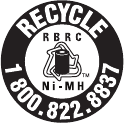
30
The RBRC
®
seal
The RBRC
®
seal on the nickel-metal
hydride battery indicates that VTech
Communications, Inc. is voluntarily
participating in an industry program to
collect and recycle these batteries at the
end of their useful lives, when taken out
of service within the United States and
Canada.
The RBRC
®
program provides a
convenient alternative to placing used
nickel-metal hydride batteries into the
trash or municipal waste, which may be
illegal in your area.
VTech’s participation in RBRC
®
makes it
easy for you to drop off the spent battery
at local retailers participating in the
RBRC
®
program or at authorized VTech
product service centers. Please call
1 (800) 8 BATTERY
®
for information on
Ni-MH battery recycling and disposal
bans/restrictions in your area. VTech’s
involvement in this program is part of its
commitment to protecting our environment
and conserving natural resources.
RBRC
®
and 1 (800) 8 BATTERY
®
are registered trademarks of
Rechargeable Battery Recycling
Corporation.
FCC, ACTA and IC
regulations
FCC Part 15
This equipment has been tested and
found to comply with the requirements
for a Class B digital device under Part
15 of the Federal Communications
Commission (FCC) rules. These
requirements are intended to provide
reasonable protection against harmful
interference in a residential installation.
This equipment generates, uses and
can radiate radio frequency energy and,
if not installed and used in accordance
with the instructions, may cause harmful
interference to radio communications.
However, there is no guarantee that
interference will not occur in a particular
installation. If this equipment does
cause harmful interference to radio
or television reception, which can be
determined by turning the equipment off
and on, the user is encouraged to try to
correct the interference by one or more
of the following measures:
Reorient or relocate the receiving
antenna.
Increase the separation between the
equipment and receiver.
Connect the equipment into an outlet
on a circuit different from that to which
the receiver is connected.
Consult the dealer or an experienced
radio/TV technician for help.
Changes or modifications to this
equipment not expressly approved by
the party responsible for compliance
could void the user’s authority to
operate the equipment.
This device complies with Part 15 of the
FCC rules. Operation is subject to the
following two conditions: (1) this device
may not cause harmful interference,
•
•
•
•


















